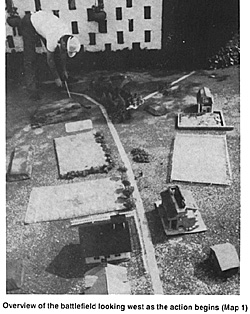 Skirmishing with 54mm figures is a type of large scale wargaming that many gamers enjoy. The look of the larger figures add a little more visual realism and personality to the game.
Overview of the battlefield looking west as the action begins (Map 1)
Skirmishing with 54mm figures is a type of large scale wargaming that many gamers enjoy. The look of the larger figures add a little more visual realism and personality to the game.
Overview of the battlefield looking west as the action begins (Map 1)
No one I knew of though, ever took the games any further than perhaps a couple of dozen figures on a regular sized game table. I found this frustrating. I enjoy the visual aspect of wargaming, and wondered, why not fight large sized engagements in this scale? Thinking about the idea, I easily solved a few of the obvious problems that cropped up.
First, to find enough room, I decided that any large game would have to be conducted on an unusually large area. Moving outside to a driveway or tennis court in good weather, or inside in a gym or large meeting room floor in bad weather, all seemed like good possibilities.
Next was terrain considerations. For buildings, I scoured area flea markets and yard sales for old Fisher-Price toy buildings. They can easily be found priced anywhere from .50 cents to $5.00 each, and they paint up to look quite good. THey could, of course, be left with their original coloring, but this is often too juvenile. For fences, I used large scale train fence available at hobby shops which stock model railroad equipment. The hills were made from two inch foam rubber appropriately cut and painted. For fields I used brown and green towels, carpet remnants, and outdoor turf carpet. The roads were two inch mailing tape in brown.
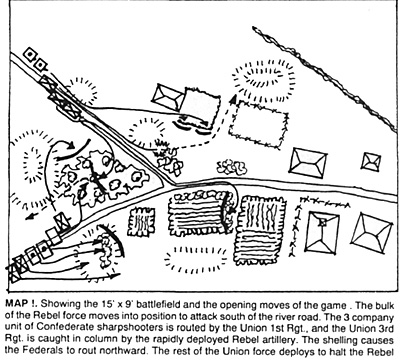 MAP I Showing the 15'x 9' battlefield and the opening moves of the game. The bulk of the Rebel force moves into position to attack south of the river road. The 3 company unit of Confederate sharpshooters is routed by the Union list Rgt., and the Union 3rd Rgt. is caught in column by the rapidly deployed Rebel artillery. The shelling causes the Federals to rout northward. The rest of the Union force deploys to halt the Rebels.
MAP I Showing the 15'x 9' battlefield and the opening moves of the game. The bulk of the Rebel force moves into position to attack south of the river road. The 3 company unit of Confederate sharpshooters is routed by the Union list Rgt., and the Union 3rd Rgt. is caught in column by the rapidly deployed Rebel artillery. The shelling causes the Federals to rout northward. The rest of the Union force deploys to halt the Rebels.
Armies can be assembled from the wide range of 54mm plastic and lead soldiers currently available. At a cost of about .50 cents a piece for plastic figures, it is very competitive with the price of better lead 25mm's. A list of sources for these figures is at the end of this article. I decided on the American Civil War because of the wide range of available poses. Armies from just about every major period could be put together though, from Ancients to Modern. I chose to assemble the bulk of my line troops in plastic, and my artillery and crews to cast in lead from molds at home. The figures can be painted up rather quickly with a simple drybrush over black prime technique. Wash the figure, prime it, then paint it all black. Next, drybrush using a large (about 1/2 inch) brush in the appropriate uniform color. Then drybrush smaller areas such as flesh, packs, and guns using a smaller brush. Details such as belts can then be added in a normal painting manner.
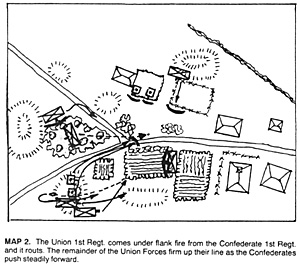 MAP 2. The Union 1st Regt. comes under flank fire from the Confederate 1st Regt. and it routs. The remainder of the Union Forces firm up their line as the Confederates push steadily forward.
MAP 2. The Union 1st Regt. comes under flank fire from the Confederate 1st Regt. and it routs. The remainder of the Union Forces firm up their line as the Confederates push steadily forward.
Another reason for choosing the Civil War was that it was a period I had already gamed in smaller scales, so I was basically familiar with the period and rules systems for it. I painted up enough men to form ' a brigade for each side. Each brigade consisted of a mounted officer, three regiments (20 figures each) and two batteries (one gun model and crew each). With the terrain and armies assembled, I prepared for a simple battle to get a feel for how a game would run in this scale. For rules I chose Rusty's Rules with all distances doubled. I chose these rules because I was most familiar with them, but see no reason why any rules system you enjoy for small sizes could not be adapted.
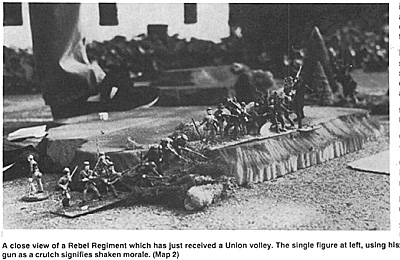 A close view of a Rebel Regiment which has just received a Union volley. The single figure at left, using his gun as a crutch signifies shaken morale. (Map 2)
A close view of a Rebel Regiment which has just received a Union volley. The single figure at left, using his gun as a crutch signifies shaken morale. (Map 2)
The scenario I picked was a simple meeting engagement I called the Battle of Rivertown. Each side would start on a separate road emerging from a large heavily wooded area off the western edge of the field. The objective for both sides would be to control the town on the eastern side of the battlefield. An area about 15'x 9' was marked off in my driveway, the terrain was set up, and the troops were set in their beginning positions.
The game flowed smoothly and did have increased visual appeal as anticipated. Another dimension was added by actually having to walk between units. It was also a bit harder to keep track of the whole battlefieldat a glance, which the birds' eye view of smaller scales permits. One note is that the moving of figures was hard on the back and knees. I recommend that you provide lawn chairs or camping stools to give the players a place to rest between moves.
I hope this encourages others of you to try out this scale. It certainly provides a change of pace from the smaller scales you are used to.
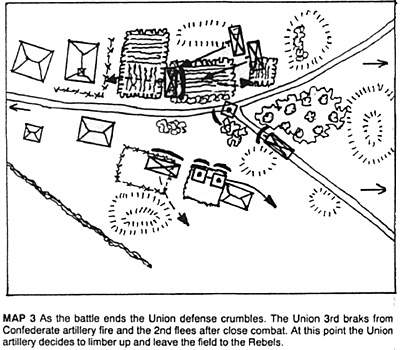 MAP 3 As the battle ends the Union defense crumbles. The Union 3rd breaks from Confederate artillery fire and the 2nd flees after close combat. At this point the Union
artillery decides to limber up and leave the field to the Rebels.
MAP 3 As the battle ends the Union defense crumbles. The Union 3rd breaks from Confederate artillery fire and the 2nd flees after close combat. At this point the Union
artillery decides to limber up and leave the field to the Rebels.
54MM PLASTIC FIGURES, MOLDS AND PRECAST METAL FIGURE SOURCES
Castings, P.O. Box 915001 Longwood, FL 32791 - (Molds only)
Coastline Enterprises, Inc., P.O. Box 1053, Bricktown, NJ 08723 - (Figures catalog - $3.00, mold catalog $3.00)
Dutkins, 1019 West Route 70, Cherry Hill, NJ 08002 - (Figures & molds - catalog $3.00)
Stone Castle Imports, 804 North Third Street, Bardstown, KY 40004 - (Figures only, catalog $6.00)
Back to Table of Contents -- Courier #57
To Courier List of Issues
To MagWeb Master Magazine List
© Copyright 1992 by The Courier Publishing Company.
This article appears in MagWeb (Magazine Web) on the Internet World Wide Web.
Other military history articles and gaming articles are available at http://www.magweb.com